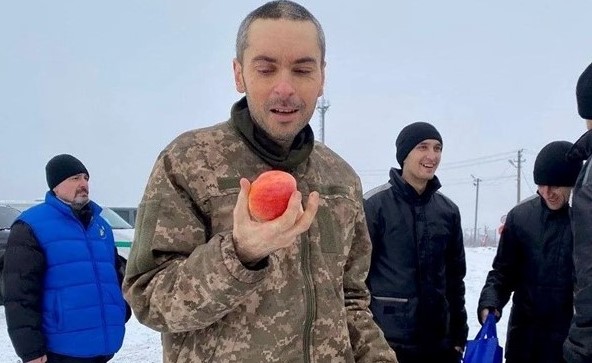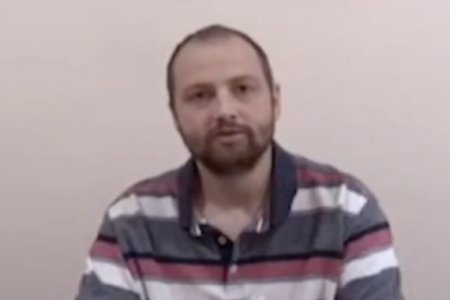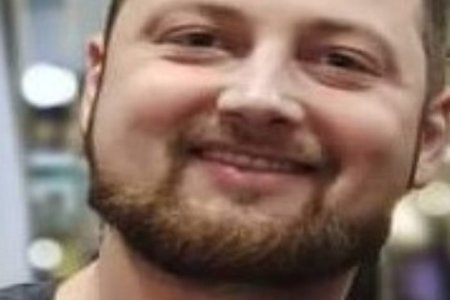
Amid the relentless images of Russian carnage and destruction, there was one photo of hope in early February, showing Ukrainian defender Maksym Kolesnikov holding the first apple he had seen in ten months as he, and other former POWs, stepped onto Ukrainian soil. 45-year-old Kolesnikov is one of the many Ukrainians who volunteered after Russia began its full-scale invasion of Ukraine. He was taken prisoner while defending Kyiv on 20 March 2022 and was held in a SIZO, or remand prison, in Russia’s Bryansk oblast until 4 February 2023 when he and 115 other Ukrainian POWs were freed in an exchange of prisoners. What would only have been clear to his family and friends was that he had lost 30 kilograms while in Russian captivity.
Neither Maksym Kolesnikov nor the other POWs were able to communicate with their families even once after they were taken prisoner. They were, finally, allowed to write four words each – saying only that they were “alive, healthy and all was well”. They had feared that even this was a lie and that the letters would not be sent, however his family did get the letter and at least knew he was alive.
For all that Kolesnikov and other POWs were held in terrible conditions and clearly did not receive enough to eat, their situation was not as difficult as that of the Ukrainian civilians whom Russia is holding hostage. In an interview to Current Time, Kolesnikov confirmed that in his SIZO, there were more Ukrainian civilians, than prisoners of war. He says that, at the beginning, he was held in a cell with 14 men, of whom only four were soldiers. In the cell next to his, there were 12 people, all of whom were civilians. It is likely that the proportions are now even worse as prisoners of war do have a chance of being exchanged, civilians – virtually none.
Kolesnikov says that the initial treatment he and the other POWs received was bad, however this improved when it became clear that the men were on the exchange list. The improvement, however, was only because the men had POW status which is, Kolesnikov notes, regulated by international agreements. In fact, Moscow has shown nothing but contempt for international agreements since 2014, but it does also have a lot of its own fighters in Ukrainian custody and presumably wants at least some of them back.
Russia is holding civilians prisoner in flagrant violation of international law. They therefore have no status and, in general, the Russians even deny holding them prisoner and, clearly, do not include them on exchange lists.
Kolesnikov notes that the Russians are themselves aware that the situation is insane, that they have simply seized civilians, “but it’s very hard to admit that their country is committing such a crime. They try, therefore, to claim that the civilian hostages are not really civilians, that they were ‘spies’, ‘saboteurs’ or helped the Ukrainian Armed Forces by directing fire, etc.
The Media Institute for Human Rights (MIHR) recently reported that around 650 Ukrainians are held prisoner at SIZO No. 2 in Bryansk oblast. Kolesnikov, when asked, confirmed only that he and the others were held in Bryansk oblast, saying he did not have the authority to specify exactly where they were imprisoned. It is, in fact, possible that it was not SIZO No. 2, since MIHR reports that Russia is denying holding any Ukrainian POWs or civilian hostages at the SIZO. At their request, a Russian lawyer visited the SIZO and was told that no Ukrainians are held there, with his request for a meeting with the SIZO management rejected. The lawyer’s contacts in Novozibkov, where SIZO No. 2 is located, assert that hundreds of Ukrainians are imprisoned there. Novozibkov is 170 kilometres from Chernihiv, and the Ukrainians imprisoned there are believed to have been seized in February and March 2022 during the Russians’ occupation of parts of Kyiv oblast.
The lawyer specifically asked for information about Ukrainian journalist Dmytro Khyliuk who is believed to be imprisoned in SIZO No. 2. Both the Russian Federal Penitentiary Service and the Russian Investigative Committee denied knowing anything about the journalist or any criminal proceedings initiated against him. Such denials are, however, standard, and could mean only that the Russians have not yet decided what to do with the person. This is known to be the case with several hostages, such as Oleksandr Babych and Iryna Horobtsova, who are illegally imprisoned in occupied Crimea. MIHR cites unnamed witnesses who say that Khysiuk is held in SIZO No. 2.
All of the Ukrainians taken prisoner in occupied parts of Kyiv oblast were first held in industrial refrigerators near the airport in Hostomel. One POW, released in a prisoner exchange, has told MIHR that he was held there for two weeks in a fridge, together with up to ten prisoners of war and around 60 civilian hostages. One of these men, Vasyl Vasyliovych (b. 1953) was then moved to SIZO No. 2 where he remains to this day. MIHR also have reason to believe that Yaroslav Hrokh, a former veteran of the military conflict in Donbas, is also imprisoned in SIZO No. 2.
All those who spoke with MIHR reported appalling treatment by the Russians at the SIZO, and also evident attempts to intimidate new arrivals as much as possible. The released POW (identified, at his wish, only as Vladislav) reported that, on their arrival, the Russians smashed all his ribs, with one still jutting out to this day. At that stage all of them were savagely beaten, around the legs and ribs, although not around the head. Later, however, when they were already in the SIZO, they would beat you around the head, with the pain making it near impossible to lie down or get up, and wounds taking a month to heal. It must be said that such treatment was not, necessarily, only directed at Ukrainians. The same is likely true of the constant hunger in all SIZO, with the main difference being that the families of Russians held in SIZO can get parcels with food and other essential items to them. With Russia not admitting to holding Ukrainians prisoner, the latter have no access to anything but prison food, medication, etc.
There are also constant interrogations, with these carried out by FSB officers in balaclavas or by people from the military prosecutor’s office. In some cases, these stop after the first one or two weeks, in others they continue, although they are often simply repeatedly asked which Ukrainian soldiers, etc. they know, or whether the men are nationalists. MIHR was told by former prisoners that the men were not tortured during these interrogations, and that the SIZO devote a lot of attention to propaganda, The prisoners were, for example, forced each morning to sing the Russian national anthem and to say ‘glory to Russia’. They were also constantly referred to by insulting labels, linked with Russia’s propaganda narrative used to justify its full-scale invasion (which Russian leader Vladimir Putin claimed to be for the so-called ‘denazification and demilitarization of Ukraine’” and were prevented from speaking Ukrainian.
Vladislav recalls that, once a week, the SIZO administration staged a so-called check of the men’s mattresses. They were forced to run along the corridor with their things to a special room where they had to undress, unfold their mattresses and shout ‘Glory to Russia”. Those ‘checking’ could just hit out at somebody, while the last person at this ‘check’ could end up having a taser gun used on them.
There were sometimes mass beatings of the Ukrainian prisoners with this clearly linked to events at the front. This, in fact, was how the prisoners effectively learned of successes by the Ukrainian Armed Forces.



